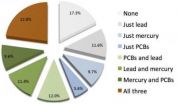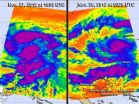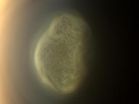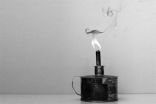(Press-News.org) MEDFORD/SOMERVILLE, Mass. (November 28, 2012) –Tufts University School of Engineering researchers have demonstrated silk-based implantable optics that offer significant improvement in tissue imaging while simultaneously enabling photo thermal therapy, administering drugs and monitoring drug delivery. The devices also lend themselves to a variety of other biomedical functions.
Biodegradable and biocompatible, these tiny mirror-like devices dissolve harmlessly at predetermined rates and require no surgery to remove them.
The technology is the brainchild of a research team led by Fiorenzo Omenetto, Frank C. Doble Professor of Engineering at Tufts. For several years, Omenetto; David L. Kaplan, Stern Family Professor of Biomedical Engineering and Biomedical Engineering chair, and their colleagues have been exploring ways to leverage silk's optical capabilities with its capacity as a resilient, biofriendly material that can stabilize materials while maintaining their biochemical functionality.
The technology is described in the paper "Implantable Multifunctional Bioresorbable Optics," published in the Proceedings of the National Academy of Sciences online Early Edition the week of November 12, 2012.
"This work showcases the potential of silk to bring together form and function. In this case an implantable optical form -- the mirror -- can go beyond imaging to serve multiple biomedical functions," Omenetto says.
Turning Silk into Mirrors
To create the optical devices, the Tufts bioengineers poured a purified silk protein solution into molds of multiple micro-sized prism reflectors, or microprism arrays (MPAs). They pre-determined the rates at which the devices would dissolve in the body by regulating the water content of the solution during processing. The cast solution was then air dried to form solid silk films in the form of the mold. The resulting silk sheets were much like the reflective tape found on safety garments or on traffic signs.
When implanted, these MPAs reflected back photons that are ordinarily lost with reflection-based imaging technologies, thereby enhancing imaging, even in deep tissue.
The researchers tested the devices using solid and liquid "phantoms" (materials that mimic the scattering that occurs when light passes through human tissue). The tiny mirror-like devices reflected substantially stronger optical signals than implanted silk films that had not been formed as MPAs.
Preventing Infection, Fighting Cancer
The Tufts researchers also demonstrated the silk mirrors' potential to administer therapeutic treatments.
In one experiment, the researchers mixed gold nanoparticles in the silk protein solution before casting the MPAs. They then implanted the gold-silk mirror under the skin of mice. When illuminated with green laser light, the nanoparticles converted light to heat. Similar in-vitro experiments showed that the devices inhibited bacterial growth while maintaining optical performance.
VIDEO:
This video shows a silk optical implant embedded with gold nano particles. As the mirror is rotates it reflects the room lighting differently.
Click here for more information.
The team also embedded the cancer-fighting drug doxorubicin in the MPAs. The embedded drug remained active even at high temperatures (60 degree C), underscoring the ability of silk to stabilize chemical and biological dopants.
When exposed to enzymes in vitro, the doxorubicin was released as the mirror gradually dissolved. The amount of reflected light decreased as the mirror degraded, allowing the researchers to accurately assess the rate of drug delivery.
"The important implication here is that using a single biofriendly, resorbable device one could image a site of interest, such as a tumor, apply therapy as needed and then monitor the progress of the therapy," says Omenetto.
INFORMATION:
Collaborating with Omenetto and Kaplan from Tufts Department of Biomedical Engineering were Hu Tao, research assistant professor; Jana M. Kainerstorfer, post-doctoral researcher; Sean M. Siebert, a Tufts undergraduate; Eleanor M. Pritchard, former post-doctoral researcher; Angelo Sassaroli, research assistant professor; Bruce J.B. Panilaitis, research assistant professor; Mark A. Brenckle, graduate student; Jason Amsden, former post-doctoral researcher; Jonathan Levitt, post-doctoral researcher, and Professor Sergio Fantini.
At Tufts, Fiorenzo Omenetto also has an appointment in the Department of Physics in the School of Arts and Sciences, and David Kaplan also has appointments in the Department of Chemical and Biological Engineering, the Department of Chemistry in the School of Arts and Sciences, the Sackler School of Graduate Biomedical Sciences, and the School of Dental Medicine.
The work was supported by the United States Army Research Laboratory, the United States Army Research Office, the Defense Advanced Research Projects Agency, the Air Force Office of Scientific Research, the Tissue Engineering Resource Center of the National Institutes of Health under award number P41EB00250 and the National Science Foundation.
Tao, H., Kainerstorfer, J.M., Siebert, S.M., Pritchard, E.M., Sassaroli, A., Panilaitis, B., Brenckle, M.A., Amsden, J., Levitt, J., Fantini, S., Kaplan, D. L., and Omenetto, F.G. (2012),.Implantable Multifunctional Bioresorbable Optics, Proceedings of the National Academy of Sciences. Doi:10.1073/pnas.1209056109
Tufts University School of Engineering
Located on Tufts' Medford/Somerville campus, the School of Engineering offers a rigorous engineering education in a unique environment that blends the intellectual and technological resources of a world-class research university with the strengths of a top-ranked liberal arts college. Close partnerships with Tufts' excellent undergraduate, graduate and professional schools, coupled with a long tradition of collaboration, provide a strong platform for interdisciplinary education and scholarship. The School of Engineering's mission is to educate engineers committed to the innovative and ethical application of science and technology in addressing the most pressing societal needs, to develop and nurture twenty-first century leadership qualities in its students, faculty, and alumni, and to create and disseminate transformational new knowledge and technologies that further the well-being and sustainability of society in such cross-cutting areas as human health, environmental sustainability, alternative energy, and the human-technology interface.
Implantable silk optics multi-task in the body
Dissolvable micro-mirrors enhance imaging, administer heat, deliver and monitor drugs
2012-11-29
ELSE PRESS RELEASES FROM THIS DATE:
Research discovery could revolutionize semiconductor manufacture
2012-11-29
A completely new method of manufacturing the smallest structures in electronics could make their manufacture thousands of times quicker, allowing for cheaper semiconductors. The findings have been published in the latest issue of Nature.
Instead of starting from a silicon wafer or other substrate, as is usual today, researchers have made it possible for the structures to grow from freely suspended nanoparticles of gold in a flowing gas.
Behind the discovery is Lars Samuelson, Professor of Semiconductor Physics at Lund University, Sweden, and head of the University's ...
Women 16-49 at risk of multiple pollutants
2012-11-29
PROVIDENCE, R.I. [Brown University] — Nearly 23 percent of American women of childbearing age met or exceeded the median blood levels for all three environmental chemical pollutants — lead, mercury, and PCBs — tracked in an analysis of data on thousands of women by Brown University researchers. All but 17.3 percent of the women aged 16 to 49 were at or above the median blood level for one or more of these chemicals, which are passed to fetuses through the placenta and to babies through breast milk.
The study, published in advance online Nov. 15 in the journal Environmental ...
URI, IAA archaeologists discover shipwrecks, ancient harbor on coast of Israel
2012-11-29
KINGSTON, R.I. – November 28, 2012 – A team of archaeologists from the University of Rhode Island, the Israel Antiquities Authority, and the University of Louisville have discovered the remains of a fleet of early-19th century ships and ancient harbor structures from the Hellenistic period (third to first century B.C.) at the city of Akko, one of the major ancient ports of the eastern Mediterranean. The findings shed light on a period of history that is little known and point to how and where additional remains may be found.
The discoveries were presented on November ...
Order of psychiatric diagnoses may influence how clinicians identify symptoms
2012-11-29
The diagnostic system used by many mental health practitioners in the United States -- known as the Diagnostic and Statistical Manual of Mental Disorders -- assumes that symptoms of two disorders that occur at the same time are additive and that the order in which the disorders are presented doesn't matter. But new research suggests that order actually plays a significant role in determining how clinicians think about psychiatric disorders.
In an article published in Clinical Psychological Science, a journal of the Association for Psychological Science, researchers Jared ...
Geosphere builds momentum with 17 newly published studies and a new series
2012-11-29
Boulder, Colo., USA – Geosphere articles posted online 16 November 2012 cover a variety of topics, such as the geophysics of the Hogri fault zone, 5 km offshore of the Diablo Canyon nuclear power plant; using web-based GIS technologies and readily available global remote sensing datasets for investigations of arid land; the structure and evolution of the U.S. Sierra Nevada; the ANDRILL McMurdo Ice Shelf and Southern McMurdo Sound Drilling Projects; and climate-tectonic interactions in the southern Alaskan orogen.
Abstracts for these and other Geosphere papers are available ...
Infrared NASA imagery sees Tropical Storm Bopha grow a tail
2012-11-29
Tropical Storm Bopha continues to intensify in the western North Pacific Ocean as it heads toward Yap State, triggering more warnings and watches. Infrared imagery from NASA's Aqua satellite captured over two days revealed that the storm had consolidated, intensified and developed a large band of strong thunderstorms south of the center, that resemble a tail.
Infrared images of Tropical Storm Bopha were taken by the AIRS instrument on NASA's Aqua satellite on Nov. 27 at 1505 UTC when Bopha had maximum sustained winds near 45 mph, and on Nov. 28 at 0329 UTC when Bopha's ...
NASA's Cassini sees abrupt turn in Titan's atmosphere
2012-11-29
Data from NASA's Cassini spacecraft tie a shift in seasonal sunlight to a wholesale reversal, at unexpected altitudes, in the circulation of the atmosphere of Saturn's moon Titan. At the south pole, the data show definitive evidence for sinking air where it was upwelling earlier in the mission. So the key to circulation in the atmosphere of Saturn's moon Titan turned out to be a certain slant of light. The paper was published today in the journal Nature.
"Cassini's up-close observations are likely the only ones we'll have in our lifetime of a transition like this in action," ...
Study IDs kerosene lamps as big source of black carbon
2012-11-29
Berkeley — The primary source of light for more than a billion people in developing nations is also churning out black carbon at levels previously overlooked in greenhouse gas estimates, according to a new study led by researchers at the University of California, Berkeley, and the University of Illinois.
Results from field and lab tests found that 7 to 9 percent of the kerosene in wick lamps — used for light in 250-300 million households without electricity — is converted to black carbon when burned. In comparison, only half of 1 percent of the emissions from burning ...
Significant progress in intelligent radio-over-fiber (I-ROF) systems
2012-11-29
Driven by the strong demand for high-definition video, digital health services, the Internet of Things, and virtual reality, broadband, ubiquitous and convergent information access has become the most important engine to drive the development of the modern information society. With increasing numbers of information-based interactions among humans, machines and objects, especially as new services, new terminals and new needs emerge, the networks are required to provide flexible, energy-efficient, safe and broadband access services anywhere at any time, and therefore wideband ...
The neural toxicity of lanthanides: An update and interpretations
2012-11-29
Lanthanides comprise a unique and dominant resource of China. The increase in contact for populations through lanthanide mining and the wide applications for industry, agriculture, and medicine have raised great public concern regarding the metal toxicity of lanthanides, particularly on the issue of whether lanthanides are toxic to the human nervous system.
In the past decade, major progresses have been made toward elucidating the mechanisms of the biological actions of lanthanides. A recently published review by researchers at Peking University [Xia et al., Sci. China ...
LAST 30 PRESS RELEASES:
Global societies unite to address environmental threats to heart health
Artificial light at night extends pollen season
Women see AI as riskier than men do
Push and pull in models of human migration
Mapping comedic timing, ta-da!
SEOULTECH researchers reveal strong public support for hydrogen fuel cell trucks
Dongguk University develops a new way to produce cheaper, more efficient green hydrogen
Scientists discover a hidden RNA “aging clock” in human sperm
New quantum boundary discovered: Spin size determines how the Kondo effect behaves
Ancient ‘spaghetti’ in dogs’ hearts reveals surprising origins of heartworm
Full value added tax on meat: a first step towards pricing the environmental damages caused by diets
Hidden mpox exposure detected in healthy Nigerian adults, revealing under-recognized transmission
Shingles vaccine linked to slower biological aging in older adults
A self-assembling shortcut to better organic solar cells
A two-week leap in breeding: Antarctic penguins’ striking climate adaptation
Climate risks to insurance and reinsurance of global supply chains
58% of patients affected by 2022 mpox outbreak report lasting physical symptoms
Golden Gate method enables rapid, fully-synthetic engineering of therapeutically relevant bacteriophages
Polar weather on Jupiter and Saturn hints at the planets’ interior details
Socio-environmental movements: key global guardians of biodiversity amid rising violence
Global warming and CO2 emissions 56 million years ago resulted in massive forest fires and soil erosion
Hidden order in quantum chaos: the pseudogap
Exploring why adapting to the environment is more difficult as people age
Society for Laboratory Automation and Screening welcomes new scientific director: Madeline M. Farley, Ph.D.
Austrian cow shows first case of flexible, multi-purpose tool use in cattle
Human nasal passages defend against the common cold and help determine how sick we get
Research alert: Spreading drug costs over the year may ease financial burden for Medicare cancer patients
Hospital partnership improves follow up scans, decreases long term risk after aortic repair
Layered hydrogen silicane for safe, lightweight, and energy-efficient hydrogen carrier
Observing positronium beam as a quantum matter wave for the first time
[Press-News.org] Implantable silk optics multi-task in the bodyDissolvable micro-mirrors enhance imaging, administer heat, deliver and monitor drugs




